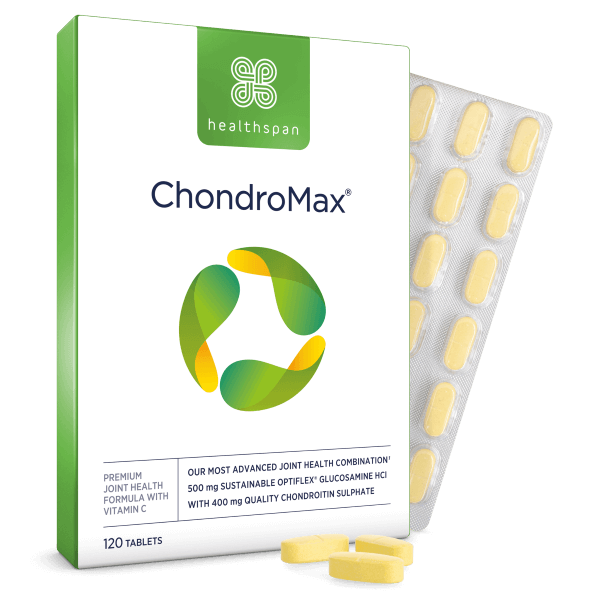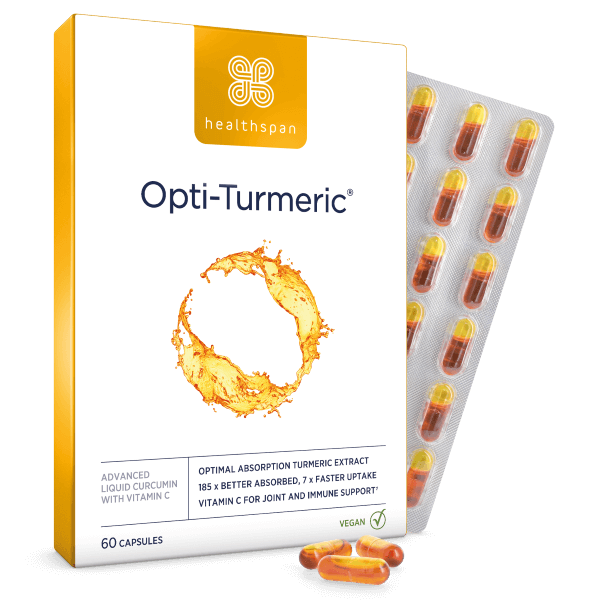Could turmeric be more effective than glucosamine when it comes to alleviating joint pain? Here's what the research tells us.
🕒 6 min read
Nobody wants to suffer with sore, achy, stiff and swollen joints, and few of us want to take the drugs conventionally used to treat them, like analgesics or non-steroidal anti-inflammatory drugs (NSAIDS), for long periods of time: not least because long-term use of NSAIDs is known to cause gastro-intestinal problems.
It is encouraging, then, that research is shining a light on how supplementing with turmeric and glucosamine can have both a protective and a pain-relieving effect on joint complaints, and that both these natural ingredients are well tolerated. These nutrients are known to help joints by protecting cartilage (the shock absorber which stops your bones from grating together) and reducing inflammation in the body.
How does turmeric help your joints?
Sometimes known as 'the golden spice of India', turmeric gives food a distinctive yellow-orange colour, and its alleged therapeutic properties have led to it being added to a whole range of foods and drinks including turmeric lattes, smoothies, teas and shots. Its active ingredient is curcumin, identified as a powerful anti-inflammatory antioxidant which has been shown to dampen down pain and reduce swelling in stiff and inflamed joints, by helping to inhibit inflammatory proteins in the body.
Curcumin is also thought to target specific inflammatory cells and some enzymes that can lead to inflammation. Like aspirin, turmeric helps to reduce abnormal blood clotting. Unlike aspirin and other non-steroidal anti-inflammatory drugs (NSAIDs), however, far from causing peptic ulcers, turmeric has been used to successfully treat gastric and duodenal ulcers, gastric erosions, gastritis and dyspepsia.
Turmeric's ability to reduce joint pain is supported by a number of randomised, controlled trials. One such study from 2009 involving 107 people with knee osteoarthritis (OA) pitted curcumin against ibuprofen for pain relief.
The curcumin was found to perform as well as the ibuprofen in relieving pain. In 2019 a randomised clinical trial involving 139 patients with knee OA compared curcumin with diclofenac, a commonly prescribed NSAID. The results showed similar pain-relieving effects to the diclofenac, but the curcumin was better tolerated by the patients.
How does glucosamine help your joints?
Glucosamine is a natural compound found in cartilage (levels of which diminish as we age) that could play a role in slowing joint deterioration, as well as provide minor pain relief. Glucosamine is often partnered with chondroitin, which is also found naturally in cartilage and helps to keep joint tissues hydrated and lubricated. This nutritional double act has been shown to help joint-cushioning cartilage and collagen from breaking down. It also has the potential to encourage the body to produce new cartilage and collagen stores.
Glucosamine and turmeric are also commonly taken to help inflammatory joint pain and conditions like osteoarthritis (OA). The landmark GAIT trial was the first large scale clinical trial to study glucosamine and chondroitin on knee OA and showed statistically significant pain relief in those experiencing moderate to severe pain when compared to a placebo.
Another study published in the New England Journal of Medicine found 53% of people suffering with mild to moderate OA felt their pain decrease by half after taking glucosamine and chondroitin tablets over a 24-week period.
A 2018 meta-analysis published in the Journal of Orthopaedic Surgery and Research concluded that glucosamine had a positive effect on relieving stiffness in the joints and chondroitin alleviated pain and improved their functioning.
There are no authorised health claims for glucosamine as a food supplement, but at doses of above 1,178mg of base glucosamine, it is classed as a medicine for 'mild to moderate osteoarthritis of the knee' by the Medicines and Healthcare products Regulatory Agency (MHRA). The fact that glucosamine is classed as a medicine at such doses reinforces how effective it can be to help your joints.

ChondroMax: High-strength Glucosamine & Chondroitin
Advanced glucosamine and chondroitin combination for joint health
- Glucosamine and chondroitin are found naturally in joints
- Premium 90% chondroitin sulphate for better absorption
- Shellfish-free glucosamine HCl and vitamin C for joints
Taking turmeric
You can get turmeric from your diet, either in fresh root form or as a powdered spice, but it is not that well absorbed by the body, and you would have to eat a lot of it to achieve the kind of amounts used therapeutically in clinical trials.
To give you an idea, it is estimated that an average Indian diet contains around 60-100mg of curcumin a day, whereas curcumin extract in supplement form will supply you with around 500mg (the amount used in trials to assess its effectiveness on joint problems).
Curcumin's absorption is significantly increased by adding black pepper (or black pepper extract known as piperine), so look for supplements with this added. Another way to speed up and optimise its absorption is to take turmeric in liquid 'nano' capsules rather than tablets.
There are no official guidelines for how much turmeric you should take daily but in trials two daily doses of 500mg were used. It is better absorbed with fats so take yours with food.
How much turmeric should I take?
There are no official guidelines for how much turmeric you should take daily but in trials two daily doses of 500mg were used. It is better absorbed with fats, so take yours with food.
Taking glucosamine
As there are few natural food sources of glucosamine, taking a supplement is the most effective way of getting this nutrient. Glucosamine tablets have traditionally been sourced from shellfish, although there are now vegetarian and vegan shellfish-free options available derived from corn.
To date most studies researching the benefits of glucosamine on joint pain in humans have focused on glucosamine sulphate, although there are other forms including glucosamine hydrochloride, which also have pain-relieving effects. N-acetyl glucosamine has been studied for its potentially therapeutic effects on arthritic disease or degenerative joint disease, and is absorbed when applied topically to the skin.
Glucosamine can be taken in tablet or capsule form, liquid or applied in a gel. To boost its joint health benefits as well as partnering up with chondroitin, vitamin C is often added to help support collagen formation, necessary for the normal functioning of cartilage and bones.
How much glucosamine should I take?
For a few years glucosamine held dual status as a medicine and a health supplement, but in the spring of 2019 the MHRA (the Medicines and Healthcare Products Regulatory Agency) significantly lowered the dose at which glucosamine products are classed as a medicine – the maximum allowable level in a food supplement is now 1,325mg.
Although there is no official recommended dosage for glucosamine in trials, daily amounts of between 1,500mg-3,000mg were taken safely in split dosages, generally with 1,200mg of chondroitin. Do allow around four weeks for the supplements to become effective and take with food to help increase their absorption.
Is it better to take glucosamine and turmeric together?
The take-home message when it comes to optimising your joint health is that turmeric is a perfect partner for glucosamine, as the two work synergistically with each other to create something of a nutritional powerhouse. Turmeric is a powerful anti-inflammatory. Glucosamine and chondroitin have a mild anti-inflammatory action but mostly act as biological signals to stimulate joint repair.
The turmeric helps your body to maintain a normal healthy inflammatory response, and the glucosamine has mild pain-relieving effects and cartilage-protective qualities. Add the complementary joint-lubricating effects of chondroitin to this mix and you appear to have a marriage made in joint health heaven.

Opti-Turmeric
7 times faster-acting than standard turmeric
- Advanced liquid curcumin capsules
- Faster-acting and better absorbed than standard turmeric
- 500mg turmeric per capsule






